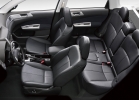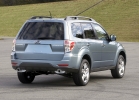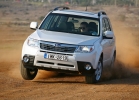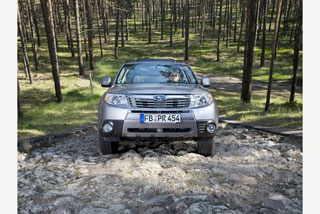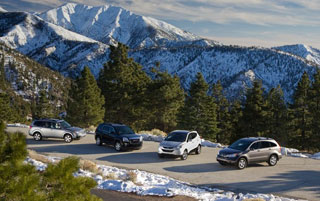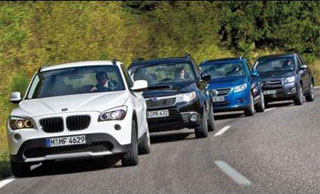Subaru Forester test drive since 2008 SUV
He left the forest
 Forester of the third generation is doomed to become a bestseller in the Subaru lineup. I can even guess how magazine articles will begin about the first test drive of the novelty: finally made a normal crossover from Forester ... In fact, the car has become larger, more spacious and more like an SUV can even be a beautiful SUV, although for The true fan of stars in the blue oval is a controversial issue. On the other hand, there is doubt. What if Subaru in vain abandoned the original inter -class concept? Was the old former a replacement?
Forester of the third generation is doomed to become a bestseller in the Subaru lineup. I can even guess how magazine articles will begin about the first test drive of the novelty: finally made a normal crossover from Forester ... In fact, the car has become larger, more spacious and more like an SUV can even be a beautiful SUV, although for The true fan of stars in the blue oval is a controversial issue. On the other hand, there is doubt. What if Subaru in vain abandoned the original inter -class concept? Was the old former a replacement? Forester is now quoted very high both among ardish subarists and people who do not fan from any brand. It is this model that is the best -selling Subaru in Europe. In Russia, it generally accounts for a share of 37% in the total sales of Subaru (according to the results of last year).
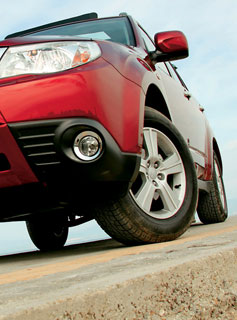 But at first, when the first foresters appeared on the roads in 1997, the new items were not very believed in the commercial success of the novelty. The car looked too utilitarian, but the idea itself seemed an absurd small station wagon with all -wheel drive and increased road clearance. In other words, an unimportant SUV from the point of view of any offroide lover and not a very spacious car from the point of view of all sheds. However, the car still found its audience. Designing the second generation (2002) Subaru did not change the concept of the car, but tried to save the forester from external grayness and spinelessness, made it more powerful, prestigious and pleasant to control. Result: Forester in different countries was recognized as a car of the year for several years (!) And became a real fan-car with a whole army of fans.
But at first, when the first foresters appeared on the roads in 1997, the new items were not very believed in the commercial success of the novelty. The car looked too utilitarian, but the idea itself seemed an absurd small station wagon with all -wheel drive and increased road clearance. In other words, an unimportant SUV from the point of view of any offroide lover and not a very spacious car from the point of view of all sheds. However, the car still found its audience. Designing the second generation (2002) Subaru did not change the concept of the car, but tried to save the forester from external grayness and spinelessness, made it more powerful, prestigious and pleasant to control. Result: Forester in different countries was recognized as a car of the year for several years (!) And became a real fan-car with a whole army of fans. It would seem that the company found a unique niche for Forester and developed the machine in the right direction by improving it within the framework of its own extra-class, without changing the overall-spring characteristics. But when creating a third generation, the engineering concept was strongly revised. And what Subaru showed now is no longer a forester. In my opinion, this car was generally called somehow differently. Forester XXL, for example.
Judge for yourself: the car has become 75 longer, 45 wider and higher as much as 110 millimeters! Forester-accelerate is distinguished by 90 millimeters of the wheel base and has a grand road clearance. He became larger than both Toyota Rav4, and Suzuki Grand Vitara crossovers, against which he always looked undergrowth. At the same time, Forester has changed its face strikingly. From one angle, he began to resemble Outlander, with another something even looks like BMW X3. No matter how you look, he looks like anyone, but not his predecessor. Unless the suffering booth on the roof of the hood of a turbocharged version hints at kinship with the most aggressive forester.
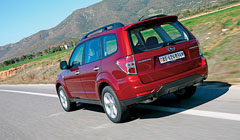 Maybe the charisma has survived inside? I pull the door handle and I feel something wrong. Well, of course, the ancestors of this family of the door were deprived of window frames! Now like everyone else. I understand: practicality, safety, etc. But still a pity. Another generic feature Forester has remained in the past.
Maybe the charisma has survived inside? I pull the door handle and I feel something wrong. Well, of course, the ancestors of this family of the door were deprived of window frames! Now like everyone else. I understand: practicality, safety, etc. But still a pity. Another generic feature Forester has remained in the past. The salon itself looks modern, the dashboard is made in the same style as on the new Subaru Impreza. There is an adjustment of the steering column in height and departure, starting the engine with a button, an advanced audio system with a car car. The turbocharged version is decorated inside more sporty (black textured fabric, aluminum). However, the interior looks good in atmospheric Forester with a black leather salon. If you do not pay attention to the particular (decorations made of painted plastic, large, but some kind of toy twisting climate control, a sonorous, clearly devoid of sound insulation of the ceiling), then the salon of the novelty visually pulls on premium standards. This will be especially felt by passengers of the second row of seats, where it has become much more comfortable and spacious.
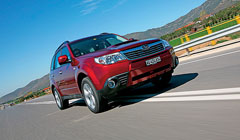 I do not remember a single automobile presentation at which the manufacturer would forget to mention the improved environmental friendliness, efficiency and increased comfort of his brainchild. Naturally, Forester was also presented under the same sauce. As for the reduced toxicity of emissions, I will believe in the word (interesting, but does this at least worry someone in Russia?). I had a completely holistic impression about the rest of the qualities after the first part of the test drive, for which I chose a model with a two-liter engine and an automatic machine. I will say briefly: I do not agree. Perhaps this is what the opponent consumes fewer liters per hundred and more modest decibels, but in order to feel this performance, you need to go oo-oh very smoothly. In real conditions, when you often accelerate and slow down, Forester is oppressed by the fuel arrow to zero with frightening haste. And everything is to blame for an automatic transmission. Yes, Sportshift has been finalized, the machine is now almost not stupid, but an obsolete four -band base makes itself felt. The motor too often has to howl at high speeds, at which, of course, there is no need to talk about savings.
I do not remember a single automobile presentation at which the manufacturer would forget to mention the improved environmental friendliness, efficiency and increased comfort of his brainchild. Naturally, Forester was also presented under the same sauce. As for the reduced toxicity of emissions, I will believe in the word (interesting, but does this at least worry someone in Russia?). I had a completely holistic impression about the rest of the qualities after the first part of the test drive, for which I chose a model with a two-liter engine and an automatic machine. I will say briefly: I do not agree. Perhaps this is what the opponent consumes fewer liters per hundred and more modest decibels, but in order to feel this performance, you need to go oo-oh very smoothly. In real conditions, when you often accelerate and slow down, Forester is oppressed by the fuel arrow to zero with frightening haste. And everything is to blame for an automatic transmission. Yes, Sportshift has been finalized, the machine is now almost not stupid, but an obsolete four -band base makes itself felt. The motor too often has to howl at high speeds, at which, of course, there is no need to talk about savings. By the way, colleagues who have chosen Forester with the same 150-horsepower engine, but with a five-speed handle (this transmission is also supplemented by a reduced nearby), were satisfied with the traction of the motor and the level of acoustic comfort.
 The senior modification with a 2.5-liter turbo engine left much more vivid impressions. A solid thrust from the bottom, not very loud, but pleasant motor accompaniment, more informative and more filled with reactive force, the steering wheel (this version uses a traditional hydraulic power steering instead of an electric power steering). This car already guesses the best features of the previous Forester. On the asphalt, behavior is very similar. The car is reluctant to turn into a turn without gas discharge, with an outright gliding of the front axle. He behaves neutral for reset. And if the front line is slightly loaded in the turn of the braking, then Forester immediately wag the back, preparing to go into the classic rally skid. This is especially manifested in gravel areas of the reaction of the car, the machine does not go out of control when stabilized, the suspension holds very reliably, swallowing large tubercles and pit without any consequences.
The senior modification with a 2.5-liter turbo engine left much more vivid impressions. A solid thrust from the bottom, not very loud, but pleasant motor accompaniment, more informative and more filled with reactive force, the steering wheel (this version uses a traditional hydraulic power steering instead of an electric power steering). This car already guesses the best features of the previous Forester. On the asphalt, behavior is very similar. The car is reluctant to turn into a turn without gas discharge, with an outright gliding of the front axle. He behaves neutral for reset. And if the front line is slightly loaded in the turn of the braking, then Forester immediately wag the back, preparing to go into the classic rally skid. This is especially manifested in gravel areas of the reaction of the car, the machine does not go out of control when stabilized, the suspension holds very reliably, swallowing large tubercles and pit without any consequences. 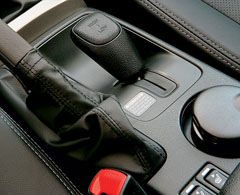 In general, at first, the new Forester does not have a dashing. The car has become much higher on such a overturning can easily. And in fact, it is chopped in turns abruptly than city SUVs like Murano, but if you compare Forester with its predecessor, then the difference is small. And there is an explanation for this. The developers managed to arrange the most massive nodes (engine, transmission) even lower, so the center of gravity of the entire car rose above the ground is not dramatic.
In general, at first, the new Forester does not have a dashing. The car has become much higher on such a overturning can easily. And in fact, it is chopped in turns abruptly than city SUVs like Murano, but if you compare Forester with its predecessor, then the difference is small. And there is an explanation for this. The developers managed to arrange the most massive nodes (engine, transmission) even lower, so the center of gravity of the entire car rose above the ground is not dramatic. In addition, I counted a whole series of advantages in the novelty. I improved the sight of the mirror large, the dead zones in front I did not notice at all, the edge of the rear window is quite low. Aerodynamic noises are blocked by double glass seals. The car is well packed with active and passive safety means. The standard equipment of all models includes dynamic stabilization. The torque on the axis is always transmitted and distributed through a differential with Wytheft.
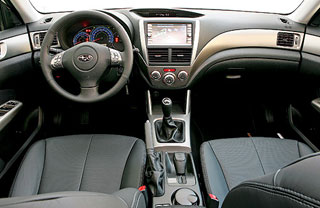 I pay attention to this, although for Subaru this is just in the order of things, just in most crossovers, all -wheel drive is made connected, which is fraught with eccentricities in controllability. The car retention system on the slope works excellently. And, in general, if we consider Forester in the new role for him, it should be recognized that Subaru performed very strongly. Although it is a little sorry that the former forester they retired. Could leave for the joy of devoted fans ...
I pay attention to this, although for Subaru this is just in the order of things, just in most crossovers, all -wheel drive is made connected, which is fraught with eccentricities in controllability. The car retention system on the slope works excellently. And, in general, if we consider Forester in the new role for him, it should be recognized that Subaru performed very strongly. Although it is a little sorry that the former forester they retired. Could leave for the joy of devoted fans ... Abstracts after
1. The third Forester is not scandalous about its primitive ancestors and generally looks like a model of another brand. Subaru thinks that this will attract a new clientele.
2. The car has become more spacious and accommodates more baggage, but it drives not as briskly as its predecessors. Only a turbo advance 2.5 gives a payload, due acceleration.
3. The proprietary system of the Subaru symmetric all -wheel drive is saved and now improved it works in the same bunch with dynamic stabilization of VDS.
4. The number one market in Europe for Subaru has become Russia. SERIOUSLY...
Subaru Forester
Gasoline engine, 4 opposition
Raboche volume (cubic cub) 1994 /2457
Power (L.S. at rpm) 150 at 6000 /230 at 5200
Moment (Nm at rpm) 196 at 3200/320 at 2800
The permanent drive is complete
The gearbox is automatic, 4-speed / mechanical 5-speed
Length/width/height (mm) 4560/1780/1700
Equipped mass (kg) 1397
Maximum speed (km / h) 185 /214
Acceleration to 100 km / h (c) 12.7 / 7.1
Fuel consumption is average, (l / 100 km) 8.4 / 10.5
The price in Moscow from 955 100 rubles. / From 1 209 400 rub.
Text: Ruslan Tarasov
Photo: Fuji Heavy Industries Ltd. And the author
A source: "Autopilot"
Video Subaru Forester test drive since 2008
Subaru Forester Crash Video since 2008
Subaru Forester test drive since 2008
Subaru Forester Crash Test since 2008
Krassh Test: Detailed Information91%
Driver and passengers
73%
Pedestrians
91%
Children-passengers
86%
Active security system


